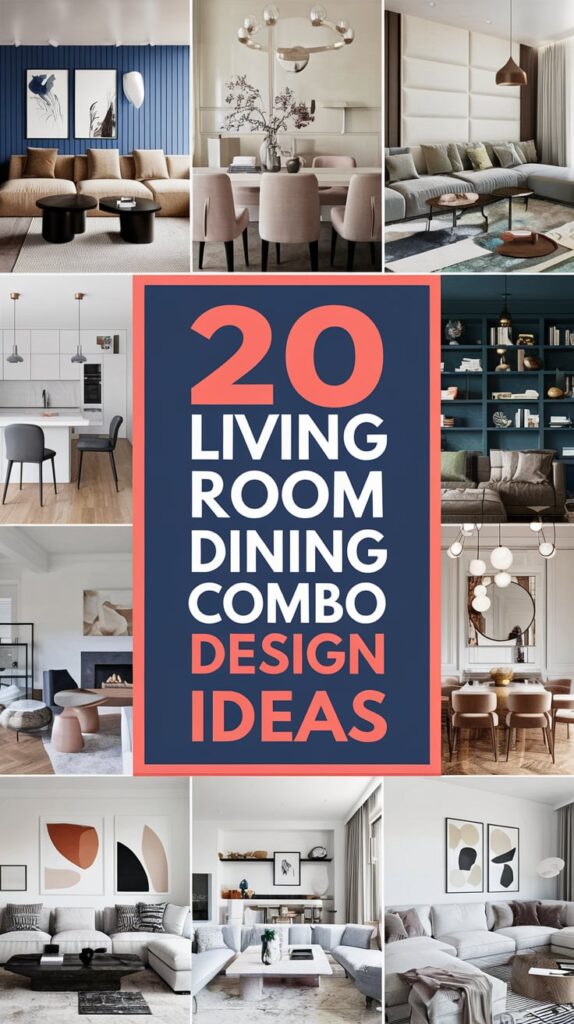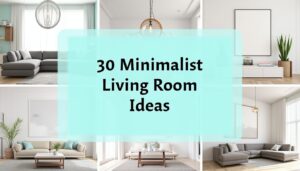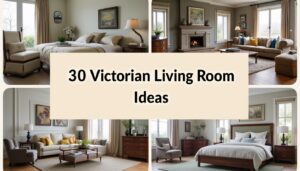Whether you’re dealing with a compact apartment or an open-concept home, these twenty living room dining combo design ideas will help you maximize your space while creating distinct zones that serve their intended purposes. From smart furniture arrangements to clever visual dividers, let’s explore how to make your multifunctional space both practical and beautiful.
1. Define Zones with Area Rugs
One of the simplest yet most effective ways to visually separate your living and dining areas is through strategically placed area rugs. In my own combo space, I placed a large jute rug under the living room furniture and a smaller patterned rug beneath the dining table, instantly creating two distinct “rooms” without any physical dividers.
For the best results, choose rugs with complementary colors but different patterns or textures. This creates cohesion while still defining separate areas. The Amazon Brand – Stone & Beam Contemporary Wool Area Rug (approximately $200 for a 5’x8′) works beautifully in living areas, while the NuLOOM Moroccan Blythe Area Rug (around $100 for a 5′ round) offers a perfect dining space definition with its circular shape that echoes a round table.
Remember to leave about 18-24 inches of flooring as a “walkway” between the rugs to create a natural transition between zones while maintaining visual flow.
2. Use a Sofa as a Room Divider
Rethinking furniture placement transformed my open space completely. Instead of pushing my sofa against the wall (my initial instinct), I floated it in the middle of the room with its back toward the dining area. This simple shift created a natural division while maximizing the available square footage.
The key is choosing a sofa with an attractive back, since it will be visible from the dining area. The Rivet Revolve Modern Sofa from Amazon (approximately $700) features clean lines and tailored details that look good from all angles. Add a narrow console table behind the sofa to create additional storage and display space—the Convenience Concepts Oxford Console Table (around $120 on Amazon) provides the perfect slim profile.
This arrangement creates a clear walking path between zones while establishing distinct areas for relaxing and dining, all without sacrificing precious floor space to walls or bulky room dividers.
3. Opt for a Round Dining Table
Square footage constraints often make furniture selection critical. I discovered that replacing my rectangular dining table with a round one instantly improved flow in my combo space. Round tables soften the often boxy dimensions of these rooms while allowing easier navigation around them.
The Zinus Becky Farmhouse Wood Dining Table from Amazon (about $150) offers a compact yet stylish solution at 48 inches in diameter—comfortably seating four while taking up minimal visual space. For extremely tight quarters, consider the Nathan James Kalos Solid Wood Drop Leaf Dining Table (approximately $180 on Amazon), which can expand or contract based on your needs.
This simple swap eliminated awkward corners that impeded movement and created better conversation flow during dinner parties. An additional benefit: round tables are more forgiving in tight spaces since there are no sharp corners to navigate around.
4. Create Visual Cohesion with Color
While defining separate zones is important, ensuring visual harmony throughout the space is equally crucial. In my combo room, I developed a cohesive color story using varying shades of blue and natural wood tones that flow between both areas, creating distinction without disconnection.
Start with a foundational color palette of 2-3 main colors plus neutrals that work throughout the entire space. Incorporate these colors in different proportions across both zones—perhaps navy dominates in the living area while appearing as subtle accents in dining chair cushions. The POLY & BARK Trattoria Side Chair Set in navy (around $175 for two on Amazon) perfectly complements blue living room accents.
This approach maintains a unified aesthetic while still allowing each area to have its own character, preventing the space from feeling disjointed despite serving multiple functions.
5. Invest in Dual-Purpose Furniture
When space is at a premium, every piece should earn its place. Multi-functional furniture has been revolutionary in my combo space—particularly my coffee table that transforms into a dining surface when needed for larger gatherings.
The WLIVE Lift Top Coffee Table with Hidden Storage from Amazon (approximately $140) features a surface that elevates to comfortable dining or working height. For dining areas, consider the IDEALHOUSE Folding Dining Table with Wheels (around $200 on Amazon), which can expand when guests arrive or shrink when you need additional living space.
These versatile pieces adapt to your changing needs, effectively giving you two rooms worth of functionality in a single space. Look for solutions with hidden storage as an added bonus to keep clutter at bay in your hardworking combo room.
6. Define Areas with Lighting
Strategic lighting creates invisible walls that define spaces more effectively than physical barriers. In my combo room, a pendant light over the dining table and a floor lamp by the sofa instantly communicate which area is which, even when both spaces are in use simultaneously.
The HMVPL Plug-in Pendant Light from Amazon (approximately $60) creates a dining zone without permanent installation—perfect for renters. For living areas, the Brightech Maxwell LED Floor Lamp (around $80 on Amazon) provides both task lighting and a visual boundary.
For maximum impact, ensure each zone has its own lighting control. Smart bulbs like the Kasa Smart Wi-Fi LED Bulbs (approximately $25 for two on Amazon) allow you to adjust brightness and even color temperature in each area independently, further enhancing the distinct feeling of separate rooms within one space.
7. Incorporate a Banquette or Bench Seating
One of the smartest space-saving solutions I’ve implemented is replacing two dining chairs with a bench that tucks completely under the table when not in use. This simple swap opened up valuable floor space while actually increasing seating capacity for guests.
The HOOBRO Dining Bench from Amazon (approximately $90) offers a slim profile with hidden storage inside—perfect for stashing placemats or table linens. For ultimate space optimization, consider a corner banquette like the Homfa Corner Nook Dining Set (around $300 on Amazon), which provides comfortable seating while using otherwise awkward corner space.
This approach not only maximizes seating but creates a more casual, conversational dining arrangement that flows naturally into the living area, perfect for entertaining in a multifunctional space.
8. Use a Bookshelf as a Room Divider
When my open space needed more distinct separation without sacrificing light or airflow, a strategic bookshelf created the perfect semi-permeable boundary. Unlike solid walls, shelving units define spaces while still allowing conversation and connection between areas.
The IKEA KALLAX Shelf Unit available via Amazon (approximately $150) offers the ideal balance of structure and openness. Position it perpendicular to a wall with the open shelves accessible from both sides. Style the living room side with books and decorative objects, while the dining side can showcase serveware or wine glasses.
This approach maintains the airy feeling of open-concept living while creating stronger visual boundaries. The bonus storage space addresses one of the biggest challenges in compact homes—where to put all your stuff when square footage is limited.
9. Create Balance with Scale
In my small combo space, I discovered that balancing the visual weight of furniture in each zone prevents one area from overwhelming the other. My substantial sofa is balanced by an equally substantial dining table, creating harmony despite their different functions.
If your living area features a sectional sofa, balance it with a dining set that has presence, like the Dorel Living Shiloh 5-Piece Rustic Dining Set from Amazon (approximately $400). Conversely, if your dining table is the weightier element, choose lighter-scale living room pieces like the GreenForest Acrylic Coffee Table (around $120 on Amazon).
This principle of visual balance creates a more pleasing overall aesthetic while ensuring neither function dominates the space. Pay particular attention to the height of key pieces—varied heights create interest while maintaining equilibrium.
10. Utilize Vertical Space
When floor space is limited, the walls become valuable real estate. In my combo room, floating shelves above the dining area provide storage for rarely-used items while drawing the eye upward, making the ceiling appear higher.
The BAYKA Floating Shelves from Amazon (approximately $40 for a set of three) offer stylish storage without consuming precious floor space. Install them high above the dining area to store special occasion serveware or display art. For the living area, consider a tall, narrow bookcase like the Sauder Trestle 5-Shelf Bookcase (around $120 on Amazon).
This vertical thinking maximizes your available square footage while creating visual interest that makes the entire space feel larger and more deliberately designed, rather than simply cramped.
11. Unify with Consistent Flooring
When working with a combo space, continuous flooring creates a seamless foundation that helps the area feel cohesive despite serving different functions. In my apartment, I extended the same engineered hardwood throughout both zones, creating a unified backdrop for the different furniture groupings.
If replacing flooring isn’t an option, consider large-scale area rugs that cover most of each zone but maintain the same flooring visible in pathways. The nuLOOM Moroccan Blythe Rug (approximately $100-200 on Amazon depending on size) comes in various sizes and colors to complement any design scheme.
This continuous flooring approach prevents choppy visual breaks that can make a combo space feel disjointed or smaller than it actually is, allowing your eye to travel smoothly throughout the entire area.
12. Add a Slim Console Between Spaces
When my living and dining areas needed a bit more definition without a full room divider, I discovered that a narrow console table created the perfect subtle boundary while providing additional functionality for both zones.
The Convenience Concepts Oxford Console Table from Amazon (approximately $120) offers a slim profile at just 12 inches deep, making it ideal for tight spaces. Position it behind the sofa or perpendicular to the dining area to create a visual break without consuming valuable floor space.
This slender boundary serves double duty—from the living room side, it’s a spot for drinks or lighting; from the dining side, it becomes a buffet or bar area during gatherings. The visual division feels intentional without sacrificing the benefits of an open layout.
13. Mirror Strategic Placements
One of the most transformative additions to my combo space was a strategically placed mirror that reflects light and visually doubles the perceived size of the room. Positioning a large mirror where it can reflect either the living or dining area creates depth that makes the entire space feel more expansive.
The NeuType Full-Length Mirror from Amazon (approximately $130) leans elegantly against a wall without requiring installation—perfect for renters. Place it where it will reflect a window or light source to maximize brightness throughout both zones.
This simple addition not only makes the space feel larger but adds a touch of sophistication that elevates the entire room. For maximum impact, position the mirror to reflect the area that feels most constrained, creating the illusion of continued space.
14. Choose a Consistent Style Direction
When designing a combo space, I found that committing to a cohesive style direction creates harmony despite the different functions within the room. My modern farmhouse approach with consistent wooden tones and black metal accents ties both areas together while allowing for function-specific pieces.
If your style leans mid-century modern, ensure both zones incorporate those design elements. The Rivet Mid-Century Curved Back Dining Chair set from Amazon (approximately $200 for two) pairs beautifully with mid-century living room furniture like the VASAGLE Coffee Table (around $90 on Amazon).
This consistent aesthetic approach creates a professionally designed look even in a challenging multi-purpose space. While each zone should maintain its distinct function, the overarching style creates a cohesive environment that feels intentional rather than compromised.
15. Incorporate a Kitchen Island as Transition
For completely open plans that incorporate kitchen, dining, and living spaces, a kitchen island or peninsula can create a natural transition between cooking and gathering areas. In my previous apartment, a small portable island created the perfect buffer between cooking and dining functions.
The HOMCOM Kitchen Island Cart with Storage from Amazon (approximately $180) provides counter space, storage, and a visual boundary that helps define different activity zones. For even smaller spaces, consider the VASAGLE Bar Table (around $130 on Amazon) which creates a dining perch with minimal footprint.
This transitional element provides functionality for both cooking and dining while establishing a visual break that helps organize the open space into purposeful zones. The height variation from standard counter to sofa height creates natural divisions without walls.
16. Play with Ceiling Treatments
One often-overlooked opportunity in combo spaces is the ceiling. In my open-concept room, painting the ceiling above the dining area in a subtle accent color created an implied “room” without any structural changes.
If paint seems too permanent, consider the Stratton Home Decor Hanging Ceiling Medallion from Amazon (approximately $50) above your dining light fixture. This architectural element subtly defines the dining space from above without consuming valuable floor space.
This approach works particularly well in rentals where structural changes aren’t permitted but visual definition is needed. Even simple ceiling-mounted curtain tracks with sheer panels can suggest separation while maintaining the benefits of an open layout.
17. Anchor the Dining Area with a Statement Light
A bold pendant light or chandelier instantly communicates “this is where we dine” in an open-concept space. In my combo room, a dramatic fixture above the table creates a focal point that draws the eye and establishes the dining zone without physical boundaries.
The VINLUZ 6-Light Sputnik Chandelier from Amazon (approximately $130) creates architectural interest and defines the dining area from above. For a more farmhouse aesthetic, the HMVPL Farmhouse Pendant Light (around $50 on Amazon) provides similar zone-defining impact.
This overhead anchor point not only improves task lighting for dining but serves as a visual landmark that helps organize the multi-purpose space. Choose a fixture that relates to your overall design scheme while being substantial enough to command attention.
18. Create a Floating Entertainment Wall
In my combo space, the television initially posed a challenge—visible from both areas but not ideally positioned for either. The solution was creating a floating entertainment wall with a slim media console that serves both zones without dominating either.
The Walker Edison Wren Classic 6 Drawer TV Stand from Amazon (approximately $250) provides both media storage and display space while maintaining a low profile that doesn’t visually divide the room. Position it where it’s viewable from both living and dining areas during casual gatherings.
This approach transforms what could be an awkward layout challenge into a feature that enhances both zones. The shared entertainment wall becomes a unifying element rather than a competing focus, particularly valuable during gatherings where activities flow between dining and relaxing.
19. Use Mobile Furniture Pieces
Flexibility became my mantra when designing my combo space. Incorporating furniture with wheels allowed me to reconfigure the room based on different needs—expanding the dining area for dinner parties or the living space for movie nights.
The Nathan James Theo 2-Shelf Industrial Bookcase with Wheels from Amazon (approximately $110) offers stylish storage that can be repositioned as needed. Similarly, the VASAGLE Industrial Bar Cart (around $90 on Amazon) can serve as a side table, bar station, or even additional dining space when guests arrive.
This adaptability is particularly valuable in spaces that need to serve multiple functions throughout the day. Mobile pieces allow your room to evolve based on immediate needs rather than being locked into a single arrangement that represents compromise.
20. Embrace the Openness with Sightlines
After trying various dividing strategies, I ultimately discovered that sometimes embracing the openness creates the most successful combo space. Arranging furniture to maintain clear sightlines throughout the room can actually make both areas feel more spacious and connected.
The Christopher Knight Home Phinnaeus Mid-Century Modern Sofa from Amazon (approximately $450) features a lower profile that doesn’t block views across the room. Pair with the Walker Edison 4-Person Modern Glass Dining Table (around $240 on Amazon) for a similarly airy profile in the dining zone.
This approach celebrates the benefits of open-concept living—conversation that flows easily between areas, shared light sources, and a more spacious feeling overall. Rather than fighting the openness, this strategy leverages it as an asset in your multifunctional space.
Creating Your Perfect Combo Space
After experimenting with countless configurations in my own living-dining combo, I’ve discovered that successful designs balance distinction with cohesion. Each area needs its own clear identity while still relating harmoniously to the whole. Start by identifying how you actually use each zone—do you entertain frequently? Work from home? Watch TV while dining?
Your specific lifestyle needs should drive your design decisions, not just aesthetics. Remember that in smaller spaces, each piece must earn its place through both form and function. Invest in quality dual-purpose pieces rather than filling the space with separate items for each function.
Most importantly, don’t view your combo space as a compromise. With thoughtful design, these multifunctional areas can actually offer greater flexibility and connection than traditionally separated rooms. Which of these ideas might transform your living-dining challenge into your home’s greatest asset?





